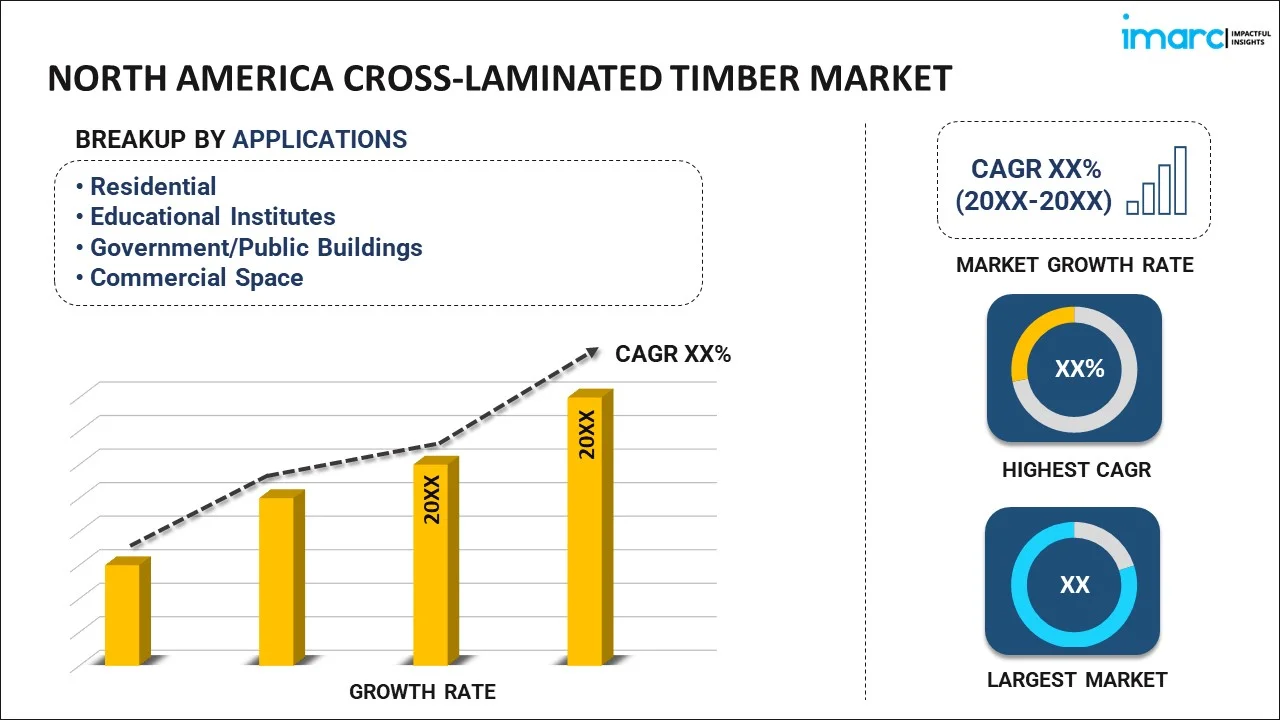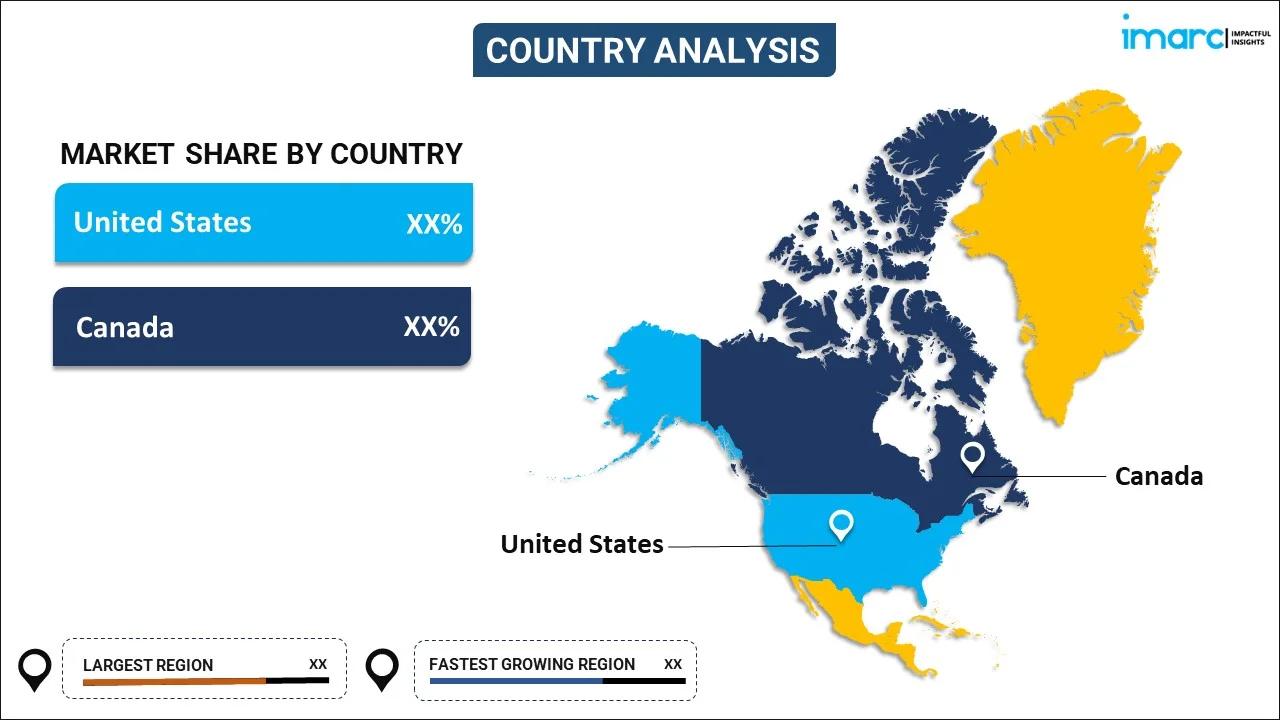
North America Cross-Laminated Timber Market Report by Application (Residential, Educational Institutes, Government/Public Buildings, Commercial Space), and Country 2025-2033
Market Overview:
The North America cross-laminated timber market size reached USD 206.4 Million in 2024. Looking forward, IMARC Group expects the market to reach USD 727.2 Million by 2033, exhibiting a growth rate (CAGR) of 14.27% during 2025-2033. The growing demand for sustainable construction materials, rising architectural innovation and design flexibility, and increasing advancements in wood processing technologies, along with the development of engineered wood products, which enable faster construction cost savings, are among the key factors driving the market growth.
|
Report Attribute
|
Key Statistics
|
|---|---|
|
Base Year
|
2024 |
|
Forecast Years
|
2025-2033
|
|
Historical Years
|
2019-2024
|
| Market Size in 2024 | USD 206.4 Million |
| Market Forecast in 2033 | USD 727.2 Million |
| Market Growth Rate 2025-2033 | 14.27% |
Cross-laminated timber is a versatile and sustainable building material manufactured from layers of wood panels that are stacked perpendicular to one another and bonded together using adhesives. It is considered an eco-friendly building material, as it is made from renewable resources, such as timber. It possesses a lower carbon footprint compared to concrete and steel, making it a key component of sustainable construction. It can support heavy loads and provide excellent structural performance. Furthermore, as it has good acoustic qualities, which can enhance the comfort and quietness of interior spaces when used in flooring and wall systems, the demand for cross-laminated timber is rising in North America.
At present, the increasing demand for cross-laminated timber in the construction of pedestrian and vehicular bridges due to its efficient durability and capability of sustaining heavy loads is impelling the growth of the market in North America. Besides this, the rising utilization of innovative construction solutions that can address the challenges of limited space and infrastructure development is contributing to the growth of the market in North America. In addition, the growing shift towards sustainable urban planning and the promotion of green buildings is offering a favorable market outlook. Apart from this, increasing advancements in wood processing technologies and the development of engineered wood products, which enable faster construction, cost savings, and improved thermal performance, are supporting the growth of the market in the region. Additionally, the rising awareness about the benefits associated with cross-laminated timber, such as reduced construction time, lower labor costs, and superior seismic resistance, is strengthening the growth of the market in North America.
North America Cross-Laminated Timber Market Trends/Drivers:
Growing Demand for Sustainable Construction Materials
The growing demand for sustainable construction materials is currently exerting a positive influence on the expansion of the cross-laminated timber market. Besides this, as society is becoming more cognizant of the adverse effects of traditional construction materials, such as concrete and steel, on the environment, there is a rising preference for sustainable alternatives. Cross-laminated timber, composed of multiple layers of timber planks adhered together at right angles, has emerged as a frontrunner in this paradigm shift toward sustainability. Moreover, cross-laminated timber is derived from renewable sources, primarily wood, which is harvested and managed in an environmentally responsible manner. This ensures the preservation of forests and reduces the carbon footprint associated with building construction.
Rising Trend Architectural Innovation and Design Flexibility
The rising trend of architectural innovation and the increasing demand for design flexibility are currently exerting a positive influence on the growth of the cross-laminated timber market. Architectural innovation is being embraced by designers, architects, and engineers who are seeking sustainable and environmentally friendly building materials. Cross-laminated timber, with its exceptional structural properties and aesthetic appeal, is emerging as a preferred choice for these professionals. Its ability to facilitate innovative and imaginative designs, such as curved and unique shapes, is currently driving demand in the construction sector. Furthermore, the present emphasis on sustainable and eco-conscious construction practices is bolstering the expansion of cross-laminated timber.
North America Cross-Laminated Timber Industry Segmentation:
IMARC Group provides an analysis of the key trends in each segment of the North America cross-laminated timber market report, along with forecasts at the region and country levels for 2025-2033. Our report has categorized the market based on application.
Breakup by Application:

- Residential
- Educational Institutes
- Government/Public Buildings
- Commercial Space
Residential represents the most widely used product type
The report has provided a detailed breakup and analysis of the market based on the application. This includes residential, educational institutes, government/public buildings, and commercial space. According to the report, residential represented the largest segment.
Cross-laminated timber is an environmentally friendly building material as it is made from renewable resources, such as timber. Using cross-laminated timber in residential construction can help lower the carbon footprint of buildings and promote sustainability. Cross-laminated timber can be used to create unique and aesthetically pleasing residential designs. Its versatility allows for various architectural styles and configurations.
Cross-laminated timber panels are prefabricated off-site, which accelerates construction timelines. This is especially advantageous for educational institutions with tight schedules, as it allows for quicker project completion and minimizes disruptions on campus.
Government buildings often need to adhere to sustainability goals and regulations. Cross-laminated timber is an eco-friendly choice as it is made from renewable timber resources, reduces carbon emissions, and has a lower environmental impact compared to traditional construction materials. Cross-laminated timber panels are prefabricated off-site, which can significantly reduce construction time. This is advantageous for government projects with tight timelines, such as emergency response facilities or disaster relief shelters.
Breakup by Country:

- United States
- Canada
Canada exhibits a clear dominance, accounting for the largest polyvinyl chloride market share
The market research report has also provided a comprehensive analysis of all the major regional markets, which include the United States and Canada. According to the report, Canada accounted for the largest market share.
Canada held the biggest market share due to the increasing demand for sustainable construction materials that have a minimum carbon footprint compared to traditional construction products like concrete and steel. Besides this, the rising construction of numerous luxury residential buildings with aesthetic interiors is contributing to the growth of the market. Apart from this, the increasing focus on maintaining fire safety in buildings to prevent fire outbreaks and dangerous situations is supporting the growth of the market. Additionally, the rising production of mass timber products, including glulam and nail-laminated timber, is strengthening the growth of the market.
United States is estimated to expand further in this domain due to the rising demand for flexible and cost-efficient construction materials. Moreover, the increasing construction of functional living spaces is bolstering the growth of the market.
Competitive Landscape:
Key market players are investing in improving their production capacity to fulfil the rising need for cross-laminated timber products. They are also building new manufacturing facilities or retrofitting existing ones to increase efficiency and output. Leading market players are investing in research operations to create innovative cross-laminated timber products. They are also developing new types of cross-laminated timber panels, such as thicker panels, fire-resistant cross-laminated timber, and acoustic cross-laminated timber, to cater to a wider range of construction applications. Top companies are focusing on promoting their sustainability credentials. They are also sourcing timber from sustainable forests, optimizing production processes to minimize waste, and obtaining certifications to demonstrate their commitment to sustainability.
The report has provided a comprehensive analysis of the competitive landscape in the market. Detailed profiles of all major companies have also been provided. Some of the key players in the market include:
- D.R. Johnson Lumber Co.
- Nordic Structures
- SmartLam NA
- Sterling Lumber
- StructureCraft
- Structurlam Mass Timber Corporation
Recent Developments:
- In April 2023, Structurlam Mass Timber Corporation announced that it has signed a stalking horse asset purchase agreement with Mercer International Inc. to sell substantially all the assets of the company in British Columbia and Arkansas for US$60 million and to improve their operational efficiency and production.
- In September 2020, SmartLam NA announced that they are building a $50M glulam manufacturing facility in Dothan, AL, which will manufacture annually 84,000,000 board feet of large glulam beams and columns.
North America Cross-Laminated Timber Market Report Scope:
| Report Features | Details |
|---|---|
| Base Year of the Analysis | 2024 |
| Historical Period | 2019-2024 |
| Forecast Period | 2025-2033 |
| Units | Million USD, Cubic Metres |
| Scope of the Report | Exploration of Historical Trends and Market Outlook, Industry Catalysts and Challenges, Segment-Wise Historical and Predictive Market Assessment:
|
| Applications Covered | Residential, Educational Institutes, Government/Public Buildings, Commercial Space |
| Countries Covered | United States, Canada |
| Companies Covered | D.R. Johnson Lumber Co., Nordic Structures, SmartLam NA, Sterling Lumber, StructureCraft. and Structurlam Mass Timber, Corporation, etc. |
| Customization Scope | 10% Free Customization |
| Post-Sale Analyst Support | 10-12 Weeks |
| Delivery Format | PDF and Excel through Email (We can also provide the editable version of the report in PPT/Word format on special request) |
Key Benefits for Stakeholders:
- IMARC’s industry report offers a comprehensive quantitative analysis of various market segments, historical and current market trends, market forecasts, and dynamics of the North America cross-laminated timber market from 2019-2033.
- The research report provides the latest information on the market drivers, challenges, and opportunities in the North America cross-laminated timber market.
- Porter's five forces analysis assist stakeholders in assessing the impact of new entrants, competitive rivalry, supplier power, buyer power, and the threat of substitution. It helps stakeholders to analyze the level of competition within the North America cross-laminated timber industry and its attractiveness.
- Competitive landscape allows stakeholders to understand their competitive environment and provides an insight into the current positions of key players in the market.
Key Questions Answered in This Report
The North America cross-laminated timber market was valued at USD 206.4 Million in 2024.
We expect the North America cross-laminated timber market to exhibit a CAGR of 14.27% during 2025-2033.
The rising consumer inclination towards CLT based on its design flexibility, large floor space, strong seismic performance, etc., is currently driving the North America cross-laminated timber market.
Sudden outbreak of the COVID-19 pandemic had led to the implementation of stringent lockdown regulations across the region resulting in temporary halt in numerous construction activities, thereby limiting the demand for CLT.
Based on the application, the North America cross-laminated timber market can be segmented into residential, educational institutes, government/public buildings, and commercial spaces. Currently, the residential sector holds the majority of the total market share.
On a regional level, the market has been classified into United States and Canada, where Canada currently dominates the North America cross-laminated timber market.
Some of the major players in the North America cross-laminated timber market include D.R. Johnson Lumber Co., Nordic Structures, SmartLam NA, Sterling Lumber, StructureCraft. and Structurlam Mass Timber Corporation.
Need more help?
- Speak to our experienced analysts for insights on the current market scenarios.
- Include additional segments and countries to customize the report as per your requirement.
- Gain an unparalleled competitive advantage in your domain by understanding how to utilize the report and positively impacting your operations and revenue.
- For further assistance, please connect with our analysts.
 Inquire Before Buying
Inquire Before Buying
 Speak to an Analyst
Speak to an Analyst
 Request Brochure
Request Brochure
 Request Customization
Request Customization




.webp)




.webp)












